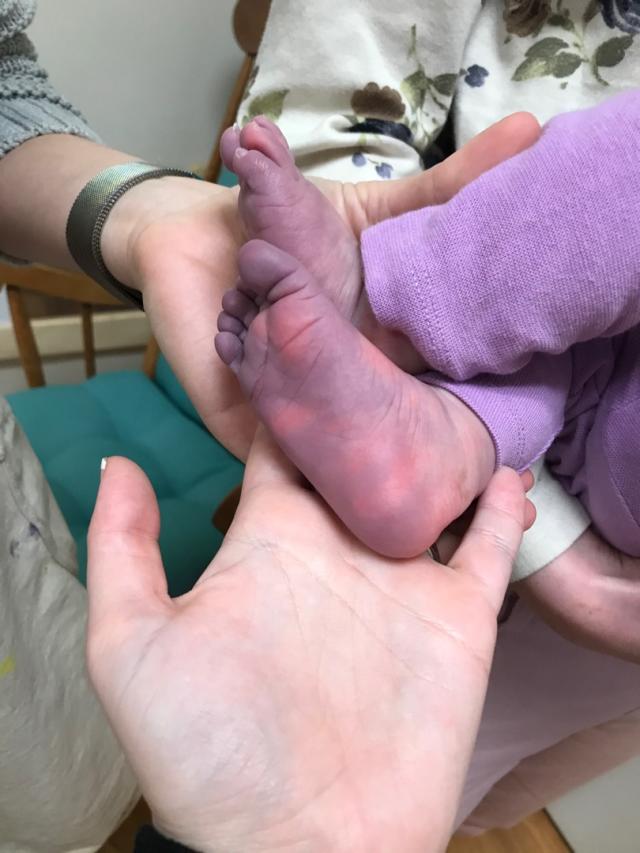A Comprehensive Guide for Parents: Understanding Why Baby Feet Turn Purple
Hello super parents! Welcome to the exciting (and sometimes bewildering!) world of parenting where every little detail about your baby becomes a new discovery. Today, we’re going to unravel the mystery behind one scenario that can cause a bit of a panic for new parents – when your baby’s feet turn purple. Don’t worry, we’ve got your back on this! Let’s dive right into it.
Understanding Your Baby’s Circulation System
First off, it’s important to note that our little ones are not just miniatures of adults. They’re unique in their own way, especially in terms of their physiology. One of the most significant differences is how the circulatory system works.
The Basics
When babies are born, they’re adjusting to a whole new world outside their mother’s womb. That includes coping with external temperatures. As a result, babies, especially newborns, have an immature circulatory system. This can lead to parts of their body like the hands and feet, turning blue or purple due to poor blood circulation. But don’t fret! It’s their little bodies finding balance in their new environment.
Why Do Baby Feet Turn Purple?
There can be several reasons why your baby’s feet might be turning purple.
Temperature Changes
The most common cause of purple discoloration in your baby’s feet is typically due to cold temperatures. This can cause temporary constriction in blood vessels making the feet appear blue or purple.
Acrocyanosis
This is a completely normal condition in newborns which results in discoloration of hands and feet. Acrocyanosis happens due to the body’s distribution of blood not being evenly spread out yet.
Less Common Causes
While it’s important to keep in mind that most reasons are harmless, there are less common causes such as heart complications that can also lead to purple discoloration. If your baby’s feet continuously remain purple, seek medical advice for peace of mind.
When To Seek Medical Advice?
While we understand that any color change in your baby’s skin can be alarming, remember that many times, this is a part of baby’s physiological adjustment. However, if the discoloration persists, is accompanied by other symptoms, or if your intuition tells you something isn’t right, it’s better to err on the side of caution. Contact your healthcare provider to ensure the health and well-being of your precious one.
Parenting is a beautiful journey filled with endless questions – and that’s perfectly okay! Remember, you’re doing great! Happy parenting!

A Comprehensive Guide for Parents: Understanding Why Baby Feet Turn Purple
Hello super parents! Welcome to the exciting (and sometimes bewildering!) world of parenting where every little detail about your baby becomes a new discovery. Today, we’re going to unravel the mystery behind one scenario that can cause a bit of a panic for new parents – when your baby’s feet turn purple. Don’t worry, we’ve got your back on this! Let’s dive right into it.
Understanding Your Baby’s Circulation System
First off, it’s important to note that our little ones are not just miniatures of adults. They’re unique in their own way, especially in terms of their physiology. One of the most significant differences is how the circulatory system works.
The Basics
When babies are born, they’re adjusting to a whole new world outside their mother’s womb. That includes coping with external temperatures. As a result, babies, especially newborns, have an immature circulatory system. This can lead to parts of their body like the hands and feet, turning blue or purple due to poor blood circulation. But don’t fret! It’s their little bodies finding balance in their new environment.
Why Do Baby Feet Turn Purple?
There can be several reasons why your baby’s feet might be turning purple.
Temperature Changes
The most common cause of purple discoloration in your baby’s feet is typically due to cold temperatures. This can cause temporary constriction in blood vessels making the feet appear blue or purple.
Acrocyanosis
This is a completely normal condition in newborns which results in discoloration of hands and feet. Acrocyanosis happens due to the body’s distribution of blood not being evenly spread out yet.
Less Common Causes
While it’s important to keep in mind that most reasons are harmless, there are less common causes such as heart complications that can also lead to purple discoloration. If your baby’s feet continuously remain purple, seek medical advice for peace of mind.
When To Seek Medical Advice?
While we understand that any color change in your baby’s skin can be alarming, remember that many times, this is a part of baby’s physiological adjustment. However, if the discoloration persists, is accompanied by other symptoms, or if your intuition tells you something isn’t right, it’s better to err on the side of caution. Contact your healthcare provider to ensure the health and well-being of your precious one.
Parenting is a beautiful journey filled with endless questions – and that’s perfectly okay! Remember, you’re doing great! Happy parenting!
Preparing for Situations When Baby Feet Turn Purple
When you’re raising a baby, it’s quite common to encounter colorful surprises. One of such situations can be noticing your baby’s feet turn purple. Understanding what it means can ease your mind and prepare you for the best course of action. Here are five things you should know.
1. Purple Feet Can Indicate Coldness
Purple or blue discoloration, also known as cyanosis, can happen if the baby’s feet are cold. Make sure your baby is properly dressed and warm, especially in cooler months.
2. Check the Baby’s General Well-being
If your baby’s feet turn purple, look at their overall behavior. If they’re calm, feeding correctly, sleeping well, and not showing signs of discomfort, this discoloration may not be a cause for alarm.
3. It can be Blood Circulation Related
Purple discoloration can sometimes indicate reduced blood circulation. Newborns’ circulatory systems are still maturing, therefore, it is common for their extremities to change color.
4. It’s Not Always a Health Warning
Generally, if the baby’s hands and feet turn slightly purple but the lips and tongue remain pink, there’s usually no need to worry. However, if other parts, like the lips or face, also turn blue or purple, contact a healthcare professional immediately.
5. Consult with A Pediatrician
If you’re worried about the discoloration, always seek advice from a pediatrician. They can help rule out any medical conditions.
To summarise, while it might be concerning to see your baby’s feet turn purple, it is often not a sign of a serious issue. However, always keep an eye on the overall comfort and behavior of your little one and consult with a healthcare professional if in doubt.
For more great articles please see here. For more information see here
Disclaimer
The articles available via our website provide general information only and we strongly urge readers to exercise caution and conduct their own thorough research and fact-checking. The information presented should not be taken as absolute truth, and, to the maximum extent permitted by law, we will not be held liable for any inaccuracies or errors in the content. It is essential for individuals to independently verify and validate the information before making any decisions or taking any actions based on the articles.




